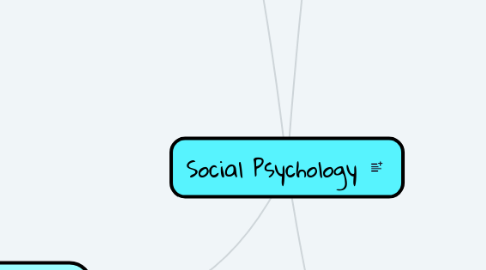
1. Situational Factors
1.1. Proximity: In variation #7, Milgram investigates whether obedience is affected if the authority figure is far away
1.2. Location: Milgram concludes that the location is much less important than the physical presence of the authority figure
1.3. Isolation: When people are alone with no one else to turn to, they tend to be more obedient
1.4. Situations & Prejudice: Sherif and Taster both propose that people easily fall into an in-group/out-group mentally
1.5. Competition: The big difference between realistic conflict and social identity theory is the importance of competition
1.6. Charismatic leaders: someone others look up to and want ti follow. Can promote prejudice and discrimination or they can oppose it.
1.7. The pathology of power: Explains discrimination, when one group has power over another group
2. Prejudice
2.1. Realistic Conflict Theory
2.1.1. CODA
2.2. Sherif (1954) Robbers Cave
2.2.1. APRC
2.2.2. GRAVE
2.2.2.1. G- 22boys in a study is a small sample meaning less of a pattern when identifying anomalies
2.2.2.2. R- he used a scoring system making it reliable
2.2.2.3. A- The study shows how competition and frustration creates hostility towards out-groups. In society, this suggests that discrimination and violence could be reduced
2.2.2.4. V- Sherif claimed that, by using several different research methods (observing, tape recording, tests, quantitative as well as qualitative data), he was making his study more valid.
2.3. Social Identity Theory
2.3.1. CODA
2.3.1.1. C: SIT is supported by Tajel. Which also shows how low self-esteem can lead to discrimination
2.3.1.2. O: Adolescent boys are naturally competitive
2.3.1.3. D: RCT claims that prejudice is produced by competition and happens when there is a scarcity of resources
2.3.1.4. A: Stratgies that increase people's sense of personal identity may reduce prejudice
2.4. Minimal Groups (Tajfel et al 1970)
2.4.1. APRC
2.4.2. CODA
3. Diagnosing Mental Health Disorders- the 4 d’s
3.1. Deviance
3.1.1. The extent to which behaviour is rare in society
3.2. Dysfunction
3.2.1. if the behaviour is massively affecting everyday life, a day to day impact
3.3. Distress
3.4. Danger
4. Schizophrenia
4.1. Causes
4.1.1. Biological
4.1.2. Non Biological
4.2. Symptoms
4.2.1. Positive
4.2.2. Negative
4.2.3. Cognitive
4.3. Explanations
4.3.1. Biological
4.3.2. Non biological
4.4. Treatments
4.4.1. Drugs
4.4.1.1. typical
4.4.1.2. atypical
4.4.2. non-biological
5. Obedience
5.1. Agency Theory
5.1.1. Autonomous: In the Autonomous State we perceive ourselves to be responsible for our own behaviour so we feel guilt for what we do
5.1.2. Agentic: In the Agentic State we perceive ourselves to be the agent of someone else’s will; the authority figure commanding us is responsible for what we do so we feel not guilt.
5.2. Moral Strain
5.2.1. When someone with an authority tells you to do something which goes against your conscience we feel strain.
5.3. Milgram Study (1963)
5.3.1. APRC
5.3.1.1. Aim: to find out if normal people would follow orders even if it meant hurting people.
5.3.1.2. Procedure: He recruited participants advertising a "memory test"which was going to be carried out at Yale University, he also told participants that they were going to get paid. After he had the participants he "randomly"chose who was the student and who the teacher. However, the learners were confederates that were part of the experiment and knew what the real experiment was about. The role of the teacher was to electrocute the learner every time he had an answer wrong to the question asked. The voltage increased by time, it started with 15V and went up to 450V.
5.3.1.3. Results: Participants were obedient until 300V. Between 300V and 375V 14 people left the experiment and the remaining 36 continued up to 450V. Milgram also collected quantitative data by observing the actions and responses the teachers had. (Sweating, trembling, groaning, etc)
5.3.1.4. Conclusions: Milgram concludes that you don't need to be a psychopath in order to follow orders that may end up hurting people. Ordinary people will do it in the right situation.
5.3.2. GRAVE
5.3.2.1. G- only male participants so can only be generalisable to men.
5.3.2.2. R- Milgrams study is reliable because it has 19 varriations
5.3.2.3. A- can be applied to the real world eg Nazis
5.3.2.4. V- this does not have much ecological validity because they were all American
5.3.2.5. E- the elthical issues in this study include: protection from harm and right to withdraw
5.4. Burger (2009)
5.4.1. APRC
5.4.1.1. Aim: To find out if the same results as Milgram study when it is replicated with 2009 participants.
5.4.1.2. Procedure:
5.4.1.3. Results: There is no big difference between the modern people obedience compared with the 1960's. Also both men and women have similar results. Empathy didn't make a significant difference but locus of control did.
5.4.1.4. Conclusion: Modern people will still obey orders and hurt people even if that went against their will.
5.4.2. GRAVE
5.4.2.1. G- good generalisability because he used men and women participants
5.4.2.2. R- reliable study because it is repeated
5.4.2.3. A- real world application
5.4.2.4. V- because there is a lack of ecological validity because it occurs in a lab
5.4.2.5. E- still protection from harm and informed consent
5.5. Social Impact Theory
5.5.1. Three Laws of Behaviour
5.5.1.1. Social Force
5.5.1.1.1. when a members of society to bring about social action or social change of some sort when there is strength in numbers . for example a war
5.5.1.2. Psychosocial Law
5.5.1.2.1. The more people tell you to do something, the more likely you are going to do it. Since you feel more pressured to.
5.5.1.3. Division of Impact
5.5.1.3.1. The impact is divided among the people the order is directed to. If it is only directed to one person then it will have a big impact.
